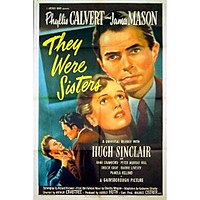They Were Sisters
| They Were Sisters | |
|---|---|

UK release poster
|
|
| Directed by | Arthur Crabtree |
| Produced by | Harold Huth |
| Written by | Roland Pertwee (from novel by Dorothy Whipple) |
| Starring |
James Mason Phyllis Calvert Dulcie Gray Anne Crawford |
| Music by | Louis Levy |
| Cinematography | Jack Cox |
| Edited by | A. Charles Knott |
|
Production
company |
|
|
Release date
|
2 July 1945 (UK) 23 July 1946 (US) |
|
Running time
|
115 min. |
| Country | United Kingdom |
| Language | English |
| Box office | over £300,000 (UK) |
They Were Sisters is a 1945 British melodrama film, directed by Arthur Crabtree for Gainsborough Pictures and starring James Mason and Phyllis Calvert. The film was produced by Harold Huth, with cinematography from Jack Cox and screenplay by Roland Pertwee. They Were Sisters is noted for its frank, unsparing depiction of marital abuse at a time when the subject was rarely discussed openly. It was one of the Gainsborough Melodramas.
Unlike most of the hugely successful melodramas made by Gainsborough during the mid-1940s, They Were Sisters has a near-contemporary rather than a costume setting, spanning the years from the immediate aftermath of World War I through to the late 1930s. The screenplay was developed by Pertwee from a popular novel of the same name by Dorothy Whipple, published in 1943.
They Were Sisters features the spouses of both Mason and Calvert; Pamela Mason (billed under her maiden name Pamela Kellino, and playing Mason's daughter despite being only seven years younger) and Peter Murray-Hill. Despite having achieved star-status via previous Gainsborough films such as The Man in Grey and Fanny by Gaslight, and being arguably the top male box-office draw in the country at the time, Mason's dissatisfaction with what he saw as the limitations of the British film industry were evident during the making of the film, and he later admitted that he acted most of his bullying, sadistic role in varying degrees of drunkenness. Nevertheless, They Were Sisters was another big hit for Gainsborough, becoming one of the top grossing films of 1945 in the UK.
The film focuses on the lives of three sisters; Lucy (Phyllis Calvert), Charlotte (Dulcie Gray) and Vera (Anne Crawford). The film opens at a dance in 1919, establishing the personalities of the four main protagonists and following them through courtship and marriage. While the sisters have remained close to one another over the years, both their characters and the paths down which their lives have travelled are very different. Lucy is the most stable of the three, a sensible and practical woman in a happy marriage, whose greatest sadness in life is her inability to have children which she sublimates by lavishing affection on her nephews and nieces. Vera is married with a child but the relationship is humdrum and loveless and she is restless and bored with her dreary home life, indulging her appetite for adventure and excitement through a series of flirtations with other men which sometimes go beyond the bounds of the socially acceptable towards the promiscuous. Charlotte is a cowed, fearful and flinching drudge, suffering severe physical and emotional abuse at the hands of her manipulative, brutal husband Geoffrey (James Mason), who constantly belittles and humiliates her in front of their three children.
...
Wikipedia
